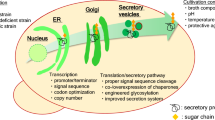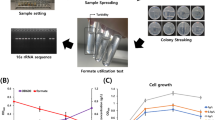Abstract
We have studied methanol-utilization in a peroxisome-deficient (PER) mutant of Hansenula polymorphoa. In spite of the fact that in carbon-limited chemostat cultures under induced conditions the enzymes involved in methanol metabolism were present at wild-type (WT) levels, this mutant is unable to grow on methanol as a sole carbon and energy source. Addition of methanol to glucose-limited (SR=12.5mM) chemostat cultures of the PER mutant only resulted in an increase in yield when small amounts were used (up to 22.5 mM). At increasing amounts however, a gradual decrease in cell density was observed which, at 80 mM methanol in the feed, had dropped below the original value of the glucose-limited culture. This reduction in yield was not observed when increasing amounts of formate instead of methanol were used as supplements for the glucose-limited mutant culture and also not in WT cells, used as control in these experiments. The effect of addition of methanol to a glucose-limited PER culture was also studied in the transient state during adaptation of the cells to methanol. The enzyme patterns obtained suggested that the ultimate decrease in yield observed at enhanced methanol concentrations was due to an inefficient methanolmetabolism as a consequence of the absence of peroxisomes. The absence of intact peroxisomes results in two major problems namely i) in H2O2-metabolism, which most probably is no longer mediated by catalase and ii) the inability of the cell to control the fluxes of formaldehyde, generated from methanol. The energetic consequences of this metabolism, compared to the WT situation with intact peroxisomes, are discussed.
Similar content being viewed by others
Abbreviations
- AO:
-
alcohol oxidase
- DHAS:
-
dihydroxyacetone synthase
- WT:
-
wild-type
- PER:
-
peroxisome-deficient
- GSH:
-
reduced glutathione
- GSSG:
-
glutathione disulphide
References
Allais JJ, Louktibi A, Baratti J (1983) Oxidation of methanol by the yeast, Pichia pastoris, purification and properties of the formaldehyde dehydrogenase. Agric Biol Chem 47:1509–1516
Babel W, Müller RH, Markuske KD (1983) Improvement of growth yield of yeasts on glycose to the maximum by using an additional energy source. Arch Microbiol 136:203–298
Bieber R, Trümpler G (1947) Angenäherte spektrographische Bestimmung der Hydratationsgleichgewichtskonstanten wäßriger Formaldehydlösungen. Helv Chim Acta 30:1860–1865
Borst P (1989) Peroxisome biogenesis revisited. Biochim Biophys Acta 1008:1–13
Bradford MM (1976) A rapid and sensitive method for the quantitation of microgram quantities of protein utilizing the principle of protein dye binding. Anal Biochem 72:248–254
Bruinenberg PG, Veenhuis M, Dijken JPvan, Duine JA, Harder W (1982) A quantitative analysis of selective inactivation of peroxisomal enzymes in the yeast Hansenula polymorpha by high-performace liquid chromatography. FEMS Microbiol Lett 15:45–50
Bystrykh LV, Koning Wde, Harder W (1990) Dihydroxyacetone synthase from Candida boidinii KD 1. In: Lidstrom ME (ed) Hydrocarbons and methylotrophy. Methods in enzymology, vol. 188. Academic Press, Orlando, Florida, pp 435–445
Cregg JM, Klei IJvan der, Sulter GJ, Veenhuis M, Harder W (1989) Peroxisome deficient mutants of Hansenula polymorpha. Yeast 6:87–97
Dijken JP van (1976) Oxidation of methanol by yeasts. PhD Thesis, University of Groningen, The Netherlands
Dijken JPvan, Otto R, Harder W (1976) Growth of Hansenula polymorpha in a methanol-limited chemostat. Physiological responses due to the involvement of methanol oxidase as a key enzyme in methanol metabolism. Arch Microbiol 111:137–144
Douma AC, Veenhuis M, Koning Wde, Evers M, Harder W (1985) Dihydroxyacetone synthase is localized in the peroxisomal matrix of methanol-grown Hansenula polymorpha. Arch Microbiol 143:237–243
Egli Th, Dijken JPvan, Veenhuis M, Harder W, Fiechter A (1980) Methanol metabolism in yeasts: regulation of the synthesis of catabolic enzymes. Arch Microbiol 124:115–121
Egli Th, Kaeppeli O, Fiechter A (1982) Regulatory flexibility of methylotrophic yeasts in chemostat cultures: simultaneous assimilation of glucose and methanol at a fixed dilution rate. Arch Microbiol 131:1–7
Erdmann R, Veenhuis M, Mertens D, Kunau WH (1989) Isolation of peroxisome-deficient mutants of Saccharomyces cerevisiae. Proc Natl Acad Sci USA 86:5419–5423
Fukui S, Tanaka A (1979) Peroxisomes of alkane- and methanol-grown yeasts. Metabolic functions and practical applications. J Appl Biochem 1:171–201
Fahimi HD, Sies H (1987) Peroxisomes in biology and medicine. Springer, Berlin Heidelberg New York
Goldberg DM, Spooner RJ (1983) Glutathione reductase. In: Bergmeyer HU (ed) Methods of enzymatic analysis, vol III. Verlag Chemie, Weinheim Deerfield Beach Basel, pp 258–265
Goldfischer S, Moor CL, Johnson AB, Spiro AJ, Valsamis MP, Wisniewski HK, Ritch RH, Norton WT, Rapi I, Garner LM (1973) Peroxisomal and mitochondrial defects in cerebrohepatorenal syndrome. Science 182:62–64
Harder W, Trotsenko YA, Bystrykh LV, Egli T (1987) Metabolic regulation in methylotrophic yeasts. In: Verseveld HWvan, Duine JA (eds) Microbial growth on C1 compounds. Martinus Nijhoff, Dordrecht, The Netherlands, pp 139–149
Kato N, Omori Y, Tani Y, Ogata K (1976) Alcohol oxidases of Kloeckera sp and Hansenula polymorpha. Catalytic properties and subunit structures. Eur J Biochem 64:341–350
Klei IJvan der, Sulter GJ, Harder W, Veenhuis M (1991) Expression, assembly and crystallization of alcohol oxidase in a peroxisome-deficient mutant of Hansenula polymorpha; properties of the protein and architecture of the crystals. Yeast 7:15–24
Laanbroek HJ, Abee T, Voogd JL (1982) Alcohol conversions by Desulfobulbus propionicus Lindhorst in the presence and absence of sulfate and hydrogen. Arch Microbiol 133:178–184
Lang E, Lang H (1972) Spezifische Farbreaktion zum direkten Nachweis der Ameisensäure. Fresenius' J Anal Chem 260:8–10
Lück H (1963) Catalase. In: Bergmeyer HU (ed) Methods in enzymatic analysis. Academic Press, New York, pp 885–894
Meister A, Anderson ME (1983) Glutathione. Ann Rev Biochem 52:711–760
Nash T (1953) The colorimetric estimation of formaldehyde by means of the Hantzsch reaction. Biochem J 55:416–421
Rodin H (1954) Correlation of ultrastructural organization and function in normal and experimentally changed proximal convoluted tubule cells of the mouse kidney. Aktiebolaget Godvil, Stockholm
Ross D, Cotgreave I, Moldéus P (1985) The interaction of reduced glutathione with active oxygen species generated by xanthineoxidase-catalyzed metabolism of xanthine. Biochim Biophys Acta 841:278–282
Schütte H, Flossdorf J, Sahm H, Kula MR (1976) Purification and properties of formaldehyde dehydrogenase and formate dehydrogenase from Candida boidinii. Eur J Biochem 62:151–160
Sahm H (1975) Oxidation of formaldehyde by alcohol oxidase of Candida boidinii. Arch Microbiol 105:179–181
Sulter GJ, Klei IJvan der, Harder W, Veenhuis M (1990) Expression and assembly of amine oxidase and D-amino acid oxidase in the cytoplasm of peroxisome-deficient mutants of the yeast Hansenula polymorpha during growth on primary amines or D-alanine as the sole nitrogen source. Yeast 6:501–509
Sibirny AA, Titorenko VI, Gonchar MV, Ubiyvovk VM, Ksheminskaya GP, Vitvitskaya OO (1988) Genetic control of methanol utilization in yeasts. J Basic Microbiol 28:293–319
Veenhuis M, Mateblowski M, Kunau WH, Harder W (1987) Proliferation of microbodies in Saccharomyces cerevisiae. Yeast 3:77–84
Veenhuis M, Harder W (1988) Microbodies in yeasts: structure, function and biogenesis. Microbiol Sci 5:347–351
Veenhuis M, Harder W (1989) Occurrence, proliferation and metabolic function of yeast microbodies. Yeast 5:517–524.
Verduyn C, Dijken JPvan, Scheffers WA (1984) Colorimetric alcohol assays with alcohol oxidase J Microbiol Methods 2:15–25
Verduyn C, Giuseppin MLF, Scheffers WA, Dijken JPvan (1988) Hydrogen peroxide metabolism in yeasts. Appl Environ Microbiol 54:2086–2090
Wanders RJA, Roermund CWTvan, Schutgens RBH, Barth PG, Heymans HSA, Bosch Hvan den, Tager JM (1990) The inborn errors of peroxisomal β-oxidation: a review. J Inherit Metab Disease 13:4–36
Zwart KB (1983) Metabolic significance of microbodies in the yeasts Candida utilis and Hansenula polymorpha. PhD Thesis, University of Groningen, The Netherlands
Zwart KB, Veenhuis M, Harder W (1983) Significance of yeast peroxisomes in the metabolism of choline and ethanolamine. Antonie van Leeuwenhoek 49:369–385
Author information
Authors and Affiliations
Rights and permissions
About this article
Cite this article
van der Klei, I.J., Harder, W. & Veenhuis, M. Methanol metabolism in a peroxisome-deficient mutant of Hansenula polymorpha: a physiological study. Arch. Microbiol. 156, 15–23 (1991). https://doi.org/10.1007/BF00418181
Received:
Accepted:
Issue Date:
DOI: https://doi.org/10.1007/BF00418181




